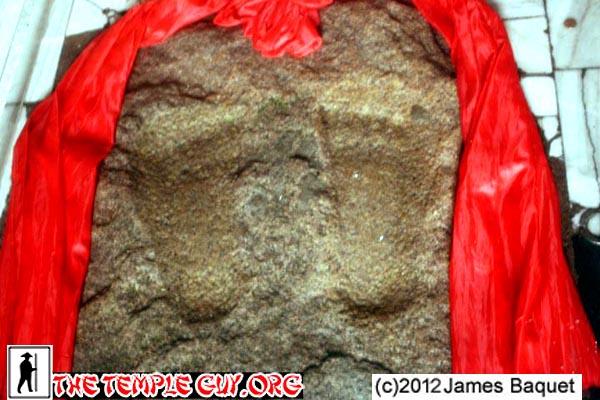(1) Gu Baijing Tai (meaning "Old Worshipping-the-Sutra Platform") is on or near the site where the Korean monk--considered the mountain's "founder"--practiced, and as such, is a key location (even though it's not one of my 142 temples). Here it is as seen from the top of the cable car.
(2) The dining hall in Gu Baijing Tai; an excellent, simple veg lunch for 20rmb ($3US).
(3) The hard-working litter-bearers of Gu Baijing Tai.
(4) A monk led me to this hall squeezed in between the two other halls; if he hadn't, I'd have missed an unusual sight...
(5) These are the very footprints of Dizang (Kshitigarbha) Bodhisattva, patron of Jiuhua Shan. They're about half-again as big as mine! They are on the floor in front of an oldish statue of Dizang; the sides of the hall have the Ten Judges of Hell.
(6) This view of the main hall at Gu Baijing Tai shows one of the halls of Tiantai Si on a crag above.
(7) It's unusual to see all four of the main Bodhisattvas in one hall, as I did in the main hall at Gu Baijing Tai. From left, Dizang (Kshitigarbha), Guanyin (Avalokiteshvara)...
(8) ...Puxian (Samantabhadra), and Wenshu (Manjushri).
(9) Relatively mundane but somehow pleasing set of three Buddhas (L to R Amitabha, Shakyamuni, and Bhaishajyaguru) in the main hall at Gu Baijing Tai.
(10) View of Gu Baijing Tai looking down from the trail up to Tiantai Si.
(11) View of Gu Baijing Tai (near center) with Tiantai Si above, as seen through the telephoto lens from near my hotel.
(12) Had I approached Gu Baijing Tai from the bottom of the mountain, this would be the first hall I encountered. As it was, I saw it by looking back on my way down the mountain.
| ← Previous Page | Back to Trip 16 Introduction | Next Site → |
Last Updated August 14, 2019













No comments:
Post a Comment